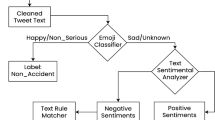Abstract
With the increasing number of vehicles in China, traffic condition analysis is of great significance to urban planning and public administration. However, the state-of-the-art traffic condition analysis approaches mainly rely on sensors, which are high cost and limited coverage. To solve these problems, we propose a semi-supervised learning method which uses the social network data instead and analyzes the traffic condition based on users’ sentiment in Chinese Microblog. This approach is a low-cost crowdsourcing solution. Firstly, we train the gated recurrent unit (GRU) model and generative adversarial networks to estimate the sentiment of Microblog with traffic information. Secondly, we calculate the Traffic Sentiment Index to predict whether traffic jams happen or not. In order to reduce the data annotated by manpower, we propose a new idea to employ the conditional generative adversarial networks to generate robust features which are used as a supplement to the training set of GRU. Finally compared with the GRU model trained by solely the manual annotation data, our method improves the classification accuracy by 3.79%. Furthermore, by using the Traffic Sentiment Index, we build a traffic condition analysis system and predict the time and roads of traffic jams in 4 Chinese cities. The predication experiment shows similar results with Baidu map which uses a lot of mobile phones as sensors, and proves the low-cost characteristic and performance of our approach.








Similar content being viewed by others
Notes
Keras: The python deep learning library. https://keras.io/.
Welcome—theano 1.0.0 documentation. http://deeplearning.net/software/theano/.
References
Cao J, Zeng K, Wang H, Cheng J, Qiao F, Wen D, Gao Y (2014) Web-based traffic sentiment analysis: methods and applications. IEEE Trans Intell Transp Syst 15(2):844–853. https://doi.org/10.1109/TITS.2013.2291241
Chen H, Zhang X, Zhao Y, Liu G, Sun J (2015) Study on spatio-temporal distribution of xiąäan traffic congestion based on micro-blog. J Shaanxi Norm Univ 43(6):83–88
Go A, Bhayani R, Huang L (2009) Twitter sentiment classification using distant supervision. Cs224n project report
Goodfellow I, Pougetabadie J, Mirza M, Xu B, Wardefarley D, Ozair S, Courville A, Bengio Y (2014) Generative adversarial nets. Adv Neural Inf Process Syst 1:2672–2680
Guo D, Cui W (2010) Trajectory mining for live traffic condition retrieving. J Wuhan Univ Technol 34(1):6–9
Hao M, Zhou D, Liu C, Lyu MR, King I (2011) Recommender systems with social regularization, Hong Kong, China, pp 287–296. https://doi.org/10.1145/1935826.1935877
Hu X, Tang J, Gao H, Liu H (2013) Unsupervised sentiment analysis with emotional signals, Rio de Janeiro, Brazil, pp 607–617
Kalchbrenner N, Blunsom P (2013) Recurrent convolutional neural networks for discourse compositionality. Comput Sci. http://arxiv.org/abs/1306.3584
Lu L, Zhiming L (2012) Empirical study of sentiment classification for Chinese microblog based on machine learning. Comput Eng Appl 48(1):1–4
Pang B, Lee L, Vaithyanathan S (2002) Thumbs up? sentiment classification using machine learning techniques. In: Proceedings of EMNLP, pp 79–86
Radford A, Metz L, Chintala S (2015) Unsupervised representation learning with deep convolutional generative adversarial networks. Comput Sci. http://arxiv.org/abs/1511.06434
Schneider W, Mrakotsky E (2005) Mobile phones as a basis for traffic state information, Vienna, Austria. pp 782–784. https://doi.org/10.1109/ITSC.2005.1520148
Shekhar H, Setty S, Mudenagudi U (2016) Vehicular traffic analysis from social media data, Jaipur, India. pp 1628–1634 https://doi.org/10.1109/ICACCI.2016.7732281
Turney PD, Littman ML (2003) Measuring praise and criticism: inference of semantic orientation from association. ACM Trans Inf Syst 21(4):315–346. https://doi.org/10.1145/944012.944013
Wang F, Wang H, Xu K, Wu J, Jia X (2013) Characterizing information diffusion in online social networks with linear diffusive model, Philadelphia, PA, United states, pp 307–316. https://doi.org/10.1109/ICDCS.2013.14
Wang S, He L, Stenneth L, Yu PS, Li Z (2015) Citywide traffic congestion estimation with social media. pp. Esri; Facebook; Google; Microsoft; NVIDIA. Seattle, WA, United states. https://doi.org/10.1145/2820783.2820829
Yang J, Leskovec J (2010) Modeling information diffusion in implicit networks, Sydney, NSW, Australia, pp 599–608. https://doi.org/10.1109/ICDM.2010.22
Zhang CB, Yang XG, Yan XP (2006) Traffic data collection system based on floating cars. Comput Commun 1:2578–2583
Zhang J, Yu-Long HE, Wei R (2010) Analysis of traffic participants’ waiting tolerance from investigative questionnaires. Transp Stand (224):121–124
Acknowledgements
The authors would like to thank the reviewers for their invaluable comments and suggestions, which greatly helped to improve the presentation of this paper.
Funding
This work was partly supported by the Welsh Government and Higher Education Funding Council for Wales through the Sĺžr Cymru National Research Network for Low Carbon, Energy and Environment (NRN-LCEE), the Nature Science Foundation of China (No. 61402386, No. 61305061, No. 61502105, No. 61572409, No. 81230087 and No. 61571188), Open Fund Project of Fujian Provincial Key Laboratory of Information Processing and Intelligent Control (Minjiang University) (No. MJUKF201743), and Education and scientific research projects of young and middle-aged teachers in Fujian Province under Grand No. JA15075. Fujian Province 2011 Collaborative Innovation Center of TCM Health Management and Collaborative Innovation Center of Chinese Oolong Tea IndustryąłCollaborative Innovation Center (2011) of Fujian Province.
Author information
Authors and Affiliations
Corresponding author
Ethics declarations
Conflict of interest
All authors declare that they have no conflict of interest.
Ethical approval
This article does not contain any studies with human participants or animals performed by any of the authors.
Additional information
Communicated by P. Angelov, F. Chao.
Publisher's Note
Springer Nature remains neutral with regard to jurisdictional claims in published maps and institutional affiliations.
Rights and permissions
About this article
Cite this article
Cao, D., Wang, S. & Lin, D. Chinese microblog users’ sentiment-based traffic condition analysis. Soft Comput 22, 7005–7014 (2018). https://doi.org/10.1007/s00500-018-3293-8
Published:
Issue Date:
DOI: https://doi.org/10.1007/s00500-018-3293-8




